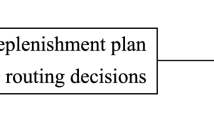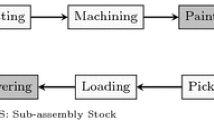Abstract
This paper considers an inventory-routing problem in a distribution network in which kanban is used as a means to implement just-in-time strategy. There are a set of part suppliers and cross-docks in this network, which provide parts for an assembly plant. A novel mixed integer non-linear programming formulation is developed for the problem in which the optimum number of kanbans is determined considering inventory and transportation cost. In the other word, this research aims at reducing the level of inventory and transportation cost in a kanban controlled supply chain system, in which the number of kanbans is to be determined optimally considering demand from suppliers and geographical distribution of them. A fleet of vehicles is applied to transport kanbans from suppliers to the assembly plant via two transportation strategies: direct shipment and shipment through cross-docks (indirect shipment). In the second strategy, it is possible to have routes between suppliers. The proposed problem is NP-hard based on literature, thus a memetic algorithm is introduced to solve it. Solving several examples reveals that the solving method significantly outperforms GAMS/CPLEX in reducing objective value and computational time.











Similar content being viewed by others
References
Aghajani M, Keramati A, Javadi B (2012) Determination of number of kanban in a cellular manufacturing system with considering rework process. Int J Adv Manuf Technol 63(9):1177–1189
Akturk MS, Erhun F (1999) An overview of design and operational issues of kanban systems. Int J Prod Res 37(17):3859–3881
Alabas C, Altiparmak F, Dengiz B (2002) A comparison of the performance of artificial intelligence techniques for optimizing the number of Kanbans. J Oper Res Soc 53(8):907–914
Arbulu R, Ballard G, Harper N (2003) Kanban in construction. In: 11th annual conference of the international group for lean construction, Virginia, USA
Belisário LS, Pierreval H (2015) Using genetic programming and simulation to learn how to dynamically adapt the number of cards in reactive pull systems. Expert Syst Appl 42(6):3129–3141
Chan FTS (2001) Effect of kanban size on just-in-time manufacturing systems. J Mater Process Technol 116:146–160
Chuah KH (2004) Optimization and simulation of just-in-time supply pickup and delivery systems. University of Kentucky Doctoral Dissertations, p 384
Ciemnoczolowski DD, Bozer YA (2013) Performance evaluation of small-batch container delivery systems used in lean manufacturing—part 2: number of Kanban and workstation starvation. Int J Prod Res 51(2):568–581
Co Henry C, Sharafali M (1997) Overlapping factor in Toyota’s formula for computing the number of Kanbans. IIE Trans 29(5):409–415
Coelho LC, Cordeau JF, Laporte G (2013) Thirty years of inventory-routing. Trans Sci 48(1):1–19
Ebrahimi DS, David P, Alpan G (2012) A model based specification for a decision support tool for supply chain risk management. In: CIE42 Proceedings, Cape Town, South Africa 2012 CIE & SAIIE
Faccio M, Gamberi M, Persona A (2013a) Kanban number optimisation in a supermarket warehouse feeding a mixed-model assembly system. Int J Prod Res 5(10):2997–3017
Faccio M, Gamberi M, Persona A, Regattieri A, Sgarbossa F (2013b) Design and simulation of assembly line feeding systems in the automotive sector using supermarket, kanbans and tow trains: a general framework. J Manag Control 24(2):187–208
González-R PL, Framinan JM, Pierreval H (2012) Token-based pull production control systems: an introductory overview. J Intell Manuf 23:5–22
Groenevelt H (1993) The just-in-time system. In: Graves SC, Rinnooy Kan AHG, Zipkin PH (eds) Handbooks in OR & MS, vol 4. Elsevier, Amsterdam, pp 629–670
Guerra L, Murino T, Romano E (2010) A system dynamics model for a single-stage multi-product kanban production system. In: ICAI’10 proceedings of the 11th WSEAS international conference on Automation & information, pp 171–176
Gupta YP, Gupta M (1989) A system dynamics model of a JIT-kanban system. Eng Costs Prod Econ 18(2):117–130
Herer YT, Shalom L (2000) The Kanban assignment problem–A non-integral approach. Eur J Oper Res 120(2):260–276
Hosseini SD, Akbarpour Shirazi M, Karimi B (2014) Cross-docking and milk run logistics in a consolidation network: a hybrid of harmony search and simulated annealing approach. J Manuf Syst 33:567–577
Hou TH, Hu WC (2011) An integrated MOGA approach to determine the Pareto-optimal kanban number and size for a JIT system. Expert Syst Appl 38:5912–5918
Huang CC, Kusiak A (1996) Overview of Kanban systems. Int J Comput Integr Manuf 9(3):169–189
Jaegler Y, Jaegler A, Burlat P, Lamouri S, Trentesaux D (2017) The ConWip production control system: a systematic review and classification. Int J Prod Res. https://doi.org/10.1080/00207543.2017.1380325
Jahantigh FF, Noroozian A, Daneshi A (2018) Using the knowledge base and fuzzy inference system to estimate the safety factor in calculating the number of the kanban card. Int J Ind Syst Eng 28(2):275–287
Junior ML, Filho MG (2010) Variations of the kanban system: literature review and classification. Int J Prod Econ 125:13–21
Kaneko J, Nojiri W (2008) The logistics of just-in-time between parts suppliers and car assemblers in Japan. J Transp Geogr 16:155–173
Kotani S (2007) Optimal Method for Changing the Number of Kanbans in the E -Kanban System and Its Applications. Int J Prod Res 45(24):5789–5809
Krieg GN, Kuhn H (2002) A decomposition method for multiproduct kanban systems with setup times and lost sales. IIE Trans 34(7):613–625
Lai CL, Lee WB, Ip WH (2003) A study of system dynamics in just-in-time logistics. J Mater Process Technol 138(1):265–269
Liu Q, Huang D (2009) Dynamic card number adjusting strategy in card-based production system. Int J Prod Res 47(21):6037–6050
Lolli F, Gamberini R, Giberti C, Rimini B, Bondi F (2016) A Simulative Approach for Evaluating Alternative Feeding Scenarios in a Kanban System. Int J Prod Res 54(14):4228–4239
Matta A, Dallery Y, Mascolo MD (2005) Analysis of assembly systems controlled with kanbans. Eur J Oper Res 166(2):310–336
Miyazaki S, Ohta H, Nishiyama N (1988) The optimal operation planning of kanban to minimize the total operation cost. Int J Product Res 26(8):1605–1611
Moattar Husseini SM, O’Brien C, Hosseini ST (2006) A method to enhance volume flexibility in JIT production control. Int J Prod Econ 104(2):653–665
Monden Y (1983) The Toyota production system. Industrial Engineering and Management Press, Norcross
Naufal A, Jaffar A, Yusoff N, Hayati N (2012) Development of kanban system at local manufacturing company in Malaysia—case study. Procedia Eng 41:1721–1726
Nori VS, Sarker BR (1996) Cyclic scheduling for a multi-product, single-facility production system operating under a just-in-time delivery policy. J Oper Res Soc 47:930–935
Nori VS, Sarker BR (1998) Optimum number of kanbans between two adjacent stations. Prod Plan Control 9:60–65
Price W, Gravel M, Nsakanda AL (1994) Review of optimization models of kanban-based production systems. Eur J Oper Res 75:1–12
Rabbani M, Layegh J, Mohammad Ebrahim R (2009) Determination of number of kanbans in a supply chain system via Memetic algorithm. Adv Eng Softw 40:431–437
Renna P (2015) A fuzzy control system to adjust the number of cards in a CONWIP-based manufacturing system. Int J Serv Oper Manag 20(2):188–206
Renna P, Magrino L, Zaffina R (2013) Dynamic card control strategy in pull manufacturing systems. Int J Comput Integr Manuf 26(9):881–894
Roser C, Meier H, Nakano M (2017) Relationship between variants and inventory under consideration of the replenishment time. Published by Springer International Publishing AG 2017, Part II, IFIP AICT, vol 514, pp 382–389
Sarker BR, Balan CV (1996) Operations planning for kanbans between two adjacent workstations. In: Randhawa Sabah U (ed) Proceedings of the 19th international conference on computers and industrial. Elsevier Science Ltd., Miami
Sarker BR, Balan CV (1998) Operations planning for a single-stage kanban system operating under linear demand. Int J Prod Res 36(2):357–375
Sarker BR, Balan CV (1999) Operations planning for a multi-stage kanban system. Eur J Oper Res 112:284–303
Sarker BR, Mukherjee S, Balan CV (1996) An order-level lot size inventory model with inventory-level dependent demand and deterioration. Int J Prod Econ 48:227–236
Shahabudeen P, Gopinath R, Krishnaiah K (2002) Design of bi-criteria Kanban system using simulates annealing technique. Comput Ind Eng 41:355–370
Sugimori Y, Kusunoki K, Oho F, Uchikawa S (1977) Toyota production system and kanban system materialization of just-in-time and respect-for-human system. Int J Prod Res 15(6):553–564
Sultana I, Ahmed I (2014) A state of art review on optimization techniques in just in time. Uncertain Supply Chain Manag 2:15–26
Tardif V, Maaseidvaag L (2001) An adaptive approach to controlling kanban systems. Eur J Oper Res 132:411–424
Tavakkoli-Moghaddam R, Gholipour-Kanani Y, Cheraghalizadeh R (2008) A genetic algorithm and memetic algorithm to sequencing and scheduling of cellular manufacturing systems. Int J Manag Sci Eng Manag 3(2):119–130
Thürer M, Fernandes NO, Stevenson M, Qu T, Li CD (2018) Centralised vs. decentralised control decision in card-based control systems: comparing kanban systems and COBACABANA. Int J Prod Res. https://doi.org/10.1080/00207543.2018.1425018
Wang S, Sarker BR (2005) An assembly-type supply chain system controlled by kanbans under a just-in time delivery policy. Eur J Oper Res 162:153–172
Wang S, Sarker BR (2006) Optimal models for a multi-stage supply chain system controlled by kanban under just-in-time philosophy. Eur J Oper Res 172(1):179–200
Wang H, Wang H (1991) Optimum number of kanbans between two adjacent workstations in a JIT system. Int J Prod Econ 22:179–188
Woolsey RE, Bowden RO, Hall JD, Hadley WH (1999) A closed form solution to a kanban sizing problem. Prod Invent Manag J 40:1–3
Xanthopoulos AS, Koulouriotis DE, Botsaris PN (2015) Single-stage kanban system with deterioration failures and condition-based preventive maintenance. Reliab Eng Syst Saf 142:111–122
Xanthopoulos AS, Koulouriotis DE, Gasteratos A (2017) Adaptive card-based production control policies. Comput Ind Eng 103:131–144
Yang L, Zhang X (2009) Design and application of kanban control system in a multi-stage, mixed-model assembly line. Syst Eng Theory Pract 29(9):64–72
Yao MJ, Hsu TC (2018) An efficient search algorithm for obtaining the optimal replenishment strategies in assembly-type just-in-time supply chain systems. J Ind Prod Eng 35(2):118–128
Author information
Authors and Affiliations
Corresponding author
Rights and permissions
About this article
Cite this article
Hasani Goodarzi, A., Zegordi, S.H. Vehicle routing problem in a kanban controlled supply chain system considering cross-docking strategy. Oper Res Int J 20, 2397–2425 (2020). https://doi.org/10.1007/s12351-018-0421-2
Received:
Revised:
Accepted:
Published:
Issue Date:
DOI: https://doi.org/10.1007/s12351-018-0421-2




